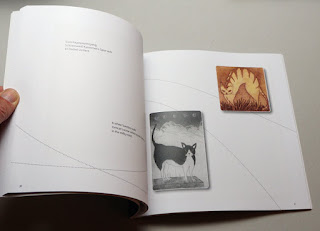In our publications we abstain from the usual CV with listings of exhibitions and biographical data. These can be read on your website. On request, we add to our aesthetic consideration of your works a short vita in the form of an elevator pitch. If necessary, the vita can be incorporated into the consideration of art in a way that is both concise and entertaining. (The consideration of a sophisticated vita-text is however an extra service.) Undoubtedly, the interplay of poems, gifts and refined statements raises the value of your pictures. It is above all the poetic context that sets our art books apart from others.
Aesthetic considerations, poems and entertaining forewords
However, the idea for our art gift books comes also from our poetic landscape. Our texts help you in your marketing efforts, even though you may feel that your art speaks entirely for itself. They are embedded in a poetic environment and work with an objective eye for you (and not against you). With their poetic beauty, they add a new dimension to the interest in your artwork.

A professionally written text about your work is a crucial part of your entire presentation as an artist. At the same time it can help you discover key aspects and relationships in your work, which you may not have noticed yet. This is also true for our entertaining forewords to a particular book.
Our Studio Gallery “Apollinaire” is an oasis of art and relaxation, set amid the same beautiful surroundings where the French poet and art critic Guillaume Apollinaire once walked. He had an intercultural personality. The artistic considerations of the images and the haiku poems in our books and blog posts are usually written by Gabriele Walter. (Haiku poetry is very popular, not only in Japan but across the world.)
As a writer and journalist, Gabriele Walter has many years’ experience working with renowned publishers. Among other things, she has had books published by Baedeker, the oldest German travel publishing house, and in the famous “Merian live!” travel book series. In their style, her considerations are inspired by the art-critical texts of Guillaume Apollinaire; they are written under advice of professional curators.

Her popular haiku poems have been published in several books and were presented at the international “Enter into Art” exhibitions together with her relaxing music – an interaction of art, poetry and sound. Not only in the field of poetry does she see herself as an “artist of the word”.
Likewise, her essays on art are suffused with poetry, paying tribute to the thinking of Guillaume Apollinaire. He too was an art critic and poet at the same time; he wrote his art criticism texts in a meditative frame of mind and emphasized again and again the connection between poetry, music and painting.

Here in our neighborhood Apollinaire had matured into a poet. His Rhénanes (Rhine songs) are among the most beautiful melodic verses in French literature. In Apollinaire, a lyrical component always resonates. His work is based on the principles that the creative process should result from the imagination or intuition and he approaches nature in the same way. The tenor of Guillaume Apollinaire’s Aesthetic Meditations is reflected in our art considerations and meditations, which art enthusiasts can use to enjoy contemporary art.
Because of his lyrical language, Apollinaire’s art-critical book “The Painters of Cubism” can also be understood as a poem about painting. You do not have to understand the painting, but perceive it – as well as poetry – through the senses. Image and text form a poetic unity of enjoyment. In this case, the sound-musical values of colors, lines and shapes are also being tested. Apollinaire par excellence embodies modernity in painting and literature. His goal was to bring together poetry and painting.
You will find examples in English or German:
- In the foreword of the bilingual book “16 times ART – 16 mal KUNST” or in the “ART EXCELLENT” series
- In the blog posts on our German website (category “Kunstbetrachtungen / Art Excellence”)
- You may have also a look to our art slogans and foreword on cultural and historical issues in the series “LOUNGE 2”.
- In our bilingual solo books
